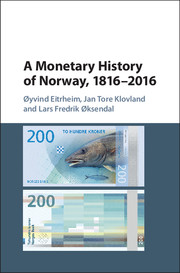Book contents
- Frontmatter
- Contents
- List of Figures
- List of Tables
- Preface
- 1 A Monetary History in Five Parts
- PART I THE LONG PROMISE, 1816–1850
- PART II THE RISE OF PRIVATE DEPOSIT-TAKING BANKS, 1850–1914
- PART III WORLDWAR I AND TURBULENT INTERWAR YEARS, 1914–1940
- PART IV MONEY IN TIMES OFWAR, CENTRAL PLANNING AND REGULATION, 1940–1986
- PART V THE LONG RETURN, 1986–2016
- 14 A Decade of Crises and Reforms, 1986–1998
- 15 Inflation Targeting: Overcoming the Fear of Floating, 1998–2016
- 16 The Future of Money Seen from the Past
- Bibliography
- Index
16 - The Future of Money Seen from the Past
from PART V - THE LONG RETURN, 1986–2016
Published online by Cambridge University Press: 09 February 2017
- Frontmatter
- Contents
- List of Figures
- List of Tables
- Preface
- 1 A Monetary History in Five Parts
- PART I THE LONG PROMISE, 1816–1850
- PART II THE RISE OF PRIVATE DEPOSIT-TAKING BANKS, 1850–1914
- PART III WORLDWAR I AND TURBULENT INTERWAR YEARS, 1914–1940
- PART IV MONEY IN TIMES OFWAR, CENTRAL PLANNING AND REGULATION, 1940–1986
- PART V THE LONG RETURN, 1986–2016
- 14 A Decade of Crises and Reforms, 1986–1998
- 15 Inflation Targeting: Overcoming the Fear of Floating, 1998–2016
- 16 The Future of Money Seen from the Past
- Bibliography
- Index
Summary
Two Hundred Years of Norwegian Monetary History
It all began with an institution chartered to issue circulating means of payments, legal tender bank notes. Two hundred years later, Norges Bank has recently commissioned what some believe might be its last series of bank notes. The recent media attention includes a number of voices who are campaigning for changes in the current legal tender regulations in order to facilitate the phasing out of paper bank notes. The end of bank notes made of paper at some future point in time does not, however, entail the end of money, but rather emphasises two fundamental historical points: the ever-changing characteristics of money and their never-changing character.
In the beginning of modern Norwegian monetary history money was bank notes, as coins had been in earlier times. At the time, bank notes were recognised as money because they were accepted as representatives of the physical units that embodied the common perception of what money really was, namely the full-bodied coins of silver, and later gold, in the vaults of Norges Bank. The understanding, perhaps even illusion, of money as a commodity has been long gone. Today we think about money as something that fulfils certain vital functions in society, notably as means of exchange, store of value and unit of account. The focal point in this monetary history, looking both backwards and forwards in time, has been to illustrate how and to what extent money has fulfilled these functions.
Bank notes came to represent, when the society's commitment to monetary stability had been successfully anchored in the early 1840s, a low risk form of money. Backed by the monetary authorities they were universally accepted, represented stable values and could easily be carried around compared with silver coins. Norway after 1816 had no substantial circulation of full-bodied coins, and the only coins in wide use were small change tokens. Although bank notes entered the bloodstream of the economy, they were not without disadvantages. Beyond the minor problems of risk of theft or destruction, notes were a costly form of money. Bank notes by definition are a non-interest-bearing liability of the issuer, and the excess holding of notes, beyond what is needed for current transactions, entails lost income for the holder.
- Type
- Chapter
- Information
- A Monetary History of Norway, 1816–2016 , pp. 589 - 600Publisher: Cambridge University PressPrint publication year: 2016

